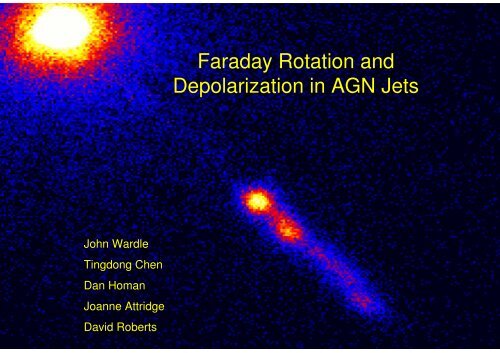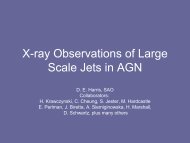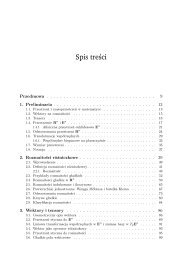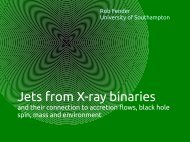Faraday Rotation and Depolarization in AGN Jets
Faraday Rotation and Depolarization in AGN Jets
Faraday Rotation and Depolarization in AGN Jets
Create successful ePaper yourself
Turn your PDF publications into a flip-book with our unique Google optimized e-Paper software.
<strong>Faraday</strong> <strong>Rotation</strong> <strong>and</strong><br />
<strong>Depolarization</strong> <strong>in</strong> <strong>AGN</strong> <strong>Jets</strong><br />
John Wardle<br />
T<strong>in</strong>gdong Chen<br />
Dan Homan<br />
Joanne Attridge<br />
David Roberts
<strong>Faraday</strong> <strong>Rotation</strong> <strong>and</strong><br />
<strong>Depolarization</strong> <strong>in</strong> <strong>AGN</strong> <strong>Jets</strong><br />
… a unique w<strong>in</strong>dow on<br />
the physics of <strong>AGN</strong><br />
John Wardle<br />
T<strong>in</strong>gdong Chen<br />
Dan Homan<br />
Joanne Attridge<br />
David Roberts
OUTLINE<br />
1. Prelim<strong>in</strong>aries – <strong>Faraday</strong> rotation <strong>and</strong> depolarization<br />
2. Pre-VLBA core rotation measures; why so small?<br />
3. The radial distribution of <strong>Rotation</strong> Measure<br />
4. The transverse gradient of <strong>Rotation</strong> Measure
Prelim<strong>in</strong>aries<br />
(1) χ(λ) = χ ο + RM . λ 2<br />
(2) RM = 8.1x10 5 f c N e B.dl rad m -2 : (cm<br />
-3<br />
, G, pc)
Prelim<strong>in</strong>aries<br />
(1) χ(λ) = χ ο + RM . λ 2<br />
(2) RM = 8.1x10 5 f c N e B.dl rad m -2 : (cm<br />
-3<br />
, G, pc)<br />
(2a) f c = (N - - N + )/(N - + N + ) = N protons /N leptons : <strong>in</strong>clude pairs<br />
(2b)<br />
for relativistic particles, n(γ) = K γ -p , γ > γ m<strong>in</strong><br />
n eq = (p-1)(p+2)/(p+1) n rel ln γ m<strong>in</strong> /γ m<strong>in</strong><br />
2<br />
~ K γ m<strong>in</strong><br />
-(1+p)<br />
(2c) = L f B : field reversals, loops etc.
Caution about Cores:<br />
1) The structure is unresolved, <strong>and</strong> often conta<strong>in</strong>s<br />
substructure with a range of <strong>Faraday</strong> depths.<br />
2) Strong spectral effects<br />
3) In an <strong>in</strong>homogeneous jet most of the radiation comes<br />
from near the τ=1 surface. Its location changes with<br />
wavelength (R(τ=1) ~ , Bl<strong>and</strong>ford-Königl), so at different<br />
wavelengths you may be look<strong>in</strong>g through different <strong>Faraday</strong><br />
screens.<br />
<strong>Faraday</strong> rotation + opacity is difficult to analyze.
<strong>Faraday</strong> <strong>Depolarization</strong>:<br />
This is due to the spread of rotation measures, ∆ RM. It comes <strong>in</strong> two<br />
varieties:<br />
a) "Side-side" ----------- by an external screen, which tells<br />
you about the environment outside the jet<br />
b) "Front-back" ----------- <strong>in</strong>ternal <strong>Faraday</strong> rotation, which<br />
tells you about the particles <strong>and</strong> fields <strong>in</strong>side the jet.
<strong>Faraday</strong> <strong>Depolarization</strong>:<br />
This is due to a spread of rotation measures, ∆ RM. It comes <strong>in</strong> two<br />
varieties:<br />
a) "Side-side" ----------- by an external screen, which tells<br />
you about the environment outside the jet<br />
b) "Front-back" ----------- <strong>in</strong>ternal <strong>Faraday</strong> rotation, which<br />
tells you about the particles <strong>and</strong> fields <strong>in</strong>side the jet.<br />
In either case (Burn 1966):<br />
p(λ 2 ) ~ p(0) exp - (∆ RM λ 2 ) 2
So how CAN you dist<strong>in</strong>guish between<br />
<strong>in</strong>ternal <strong>and</strong> external <strong>Faraday</strong> rotation?
ack<br />
front<br />
INTERNAL FARADAY ROTATION:<br />
For λ > 0, polarized radiation from<br />
the back of the source is rotated,<br />
while radiation from the front is not.<br />
observed<br />
λ = 0
ack<br />
back<br />
front<br />
front<br />
observed<br />
observed<br />
λ = 0<br />
λ= λ 1/2<br />
∆χ = 45 o<br />
p(λ) ~ 0.5 p(0)
Burn's (1966) model for<br />
<strong>in</strong>ternal <strong>Faraday</strong> rotation<br />
Here, u is a scaled<br />
wavelength (u = λ/λ 1/2<br />
), <strong>and</strong> µ<br />
is the ratio of the r<strong>and</strong>om<br />
<strong>and</strong> uniform components of<br />
rotation measure.<br />
For µ > 0 <strong>and</strong> u > 1, χ is not<br />
~ constant, but <strong>in</strong> fact<br />
executes a r<strong>and</strong>om walk.
Corollary: If the observed EVPA<br />
rotates through much more than<br />
45 o , without a decrease <strong>in</strong> the<br />
fractional polarization, then the<br />
<strong>Faraday</strong> rotation MUST be<br />
external to the emitt<strong>in</strong>g region.
The Observations<br />
a) Pre-VLBA core rotation measures<br />
b) Radial distributions of rotation measure<br />
c) Transverse gradients of rotation measure
"Core" rotation measures pre-VLBA<br />
VLA observations of compact sources typically measure<br />
just a few hundred radians/m 2 (e.g. Rudnick & Jones<br />
1983, O'Dea 1989)<br />
"Expected" values for the NLR: N e T ~ 10 8 Kcm -3<br />
so <strong>in</strong> the hot <strong>in</strong>ter-cloud medium N e ~ 10 cm -3<br />
B eq ~ 10 -3 G<br />
L ~ 100 pc<br />
this gives RM ~ 2 x 10 5 rad/m 2 ------- 1000 times too big<br />
So B
Polarization variations<br />
Altschuler & Wardle 1975 - 77 (3-element <strong>in</strong>terferometer), Aller 2 UMRAO 85'<br />
Homan, Ojha et al 2000 - 04 (VLBA), Marscher, Jorstad et al (VLBA)<br />
Variations <strong>in</strong> χ are NOT primarily due to variable rotation measure.<br />
Upper limits on <strong>in</strong>ternal <strong>Faraday</strong> rotation are so low that γ m<strong>in</strong><br />
> 100,<br />
or the source is pair dom<strong>in</strong>ated.
Radial distribution of rotation measure
GALAXIES:<br />
M 87<br />
3C 120<br />
3C 111<br />
Zavala &<br />
Taylor<br />
2002
QUASARS:<br />
3C 273 3C 279<br />
3C 345<br />
3C380<br />
Taylor 1998, 2000<br />
1928+738 3C 395<br />
2134+004 CTA 102
1803+784 (BL Lac Object, z=0.68)<br />
Zavala &<br />
Taylor<br />
2003<br />
Udomprasert<br />
et al. 1997<br />
OQ 172 (quasar, z = 3.53)<br />
Host galaxy rest frame RM is larger by (1+z) 2 = 20.5 here. For <strong>in</strong>ternal rotation <strong>in</strong> the jet,<br />
the comov<strong>in</strong>g frame RM also <strong>in</strong>cludes (Doppler factor) -2 , which will typically be larger<br />
than the redshift effect, <strong>and</strong> <strong>in</strong> the opposite direction.
CLUES ABOUT THE<br />
ENVIRONMENT<br />
Connection to ISM, cloud<br />
<strong>in</strong>teractions etc (Junor et al)<br />
Connection to <strong>AGN</strong> structure,<br />
<strong>in</strong>flow, outflow, unified models etc<br />
(Taylor et al)
Variable jet rotation<br />
measures: 3C 279<br />
Taylor & Zavala
Core <strong>Depolarization</strong><br />
43 <strong>and</strong> 86 GHz (7.0 <strong>and</strong> 3.5 mm)<br />
Attridge, Wardle & Homan 2005
Newspaper reporter: “Why do you rob banks”<br />
Willy Sutton (famous American bank robber):<br />
“That’s where the money is.”<br />
(New York City, c. 1950)
Newspaper reporter: “Why do you rob banks”<br />
Willy Sutton (famous American bank robber):<br />
“That’s where the money is.”<br />
(New York City, c. 1950)<br />
“Why observe polarization at millimeter wavelengths?”<br />
J. Wardle (who hasn’t robbed any banks yet):<br />
“That’s where the large rotation measures are.”<br />
(Krakow, 2006)
∆χ = 60 o : m<strong>in</strong>imum RMs<br />
are ± 21,000 rad/m 2<br />
43 GHz<br />
86 GHz
∆χ = 60 o : m<strong>in</strong>imum RMs<br />
are ± 20,000 rad/m 2<br />
The base of the jet is still<br />
depolarized at 86 GHz <strong>and</strong><br />
probably also at 300 GHz.<br />
This is consistent with the observed<br />
steep RM gradient, <strong>and</strong> may be<br />
connected to the accretion flow, e.g.<br />
Sgr A*, or a disk w<strong>in</strong>d.<br />
43 GHz<br />
86 GHz
∆χ = 60 o : m<strong>in</strong>imum RMs<br />
are ± 21,000 rad/m 2<br />
The base of the jet is still<br />
depolarized at 86 GHz <strong>and</strong><br />
probably also at 300 GHz.<br />
This is consistent with the observed<br />
steep RM gradient, <strong>and</strong> may be<br />
connected to the accretion flow, e.g.<br />
Sgr A*, or a disk w<strong>in</strong>d.<br />
Other quasars observed at similar<br />
l<strong>in</strong>ear resolution, might well exhibit<br />
similar properties.<br />
43 GHz<br />
86 GHz
Transverse gradient of rotation measure
Gabuzda et al 2004:<br />
RM gradients = 25 - 200 rad/m 2 /mas<br />
0745+241 0820+225<br />
1652+398 3C 371
Asada et al 2002 RM gradient = 70 rad/m 2 /mas
Asada et al 2002 RM gradient = 70 rad/m 2 /mas
Zavala & Taylor 2005<br />
• RM gradient = 70 rad/m 2 /mas RM gradient = 500 rad/m 2 /mas
Zavala & Taylor 2005<br />
• RM gradient = 70 rad/m 2 /mas RM gradient = 500 rad/m 2 /mas
∆χ = 60 o<br />
43 GHz<br />
<strong>Rotation</strong> measure<br />
gradient is<br />
130,000 rad/m 2 /mas<br />
86 GHz<br />
Attridge, Wardle <strong>and</strong> Homan (2005)
3C 273, epoch 1999.26,<br />
from 8, 15 <strong>and</strong> 22 GHz data.<br />
T<strong>in</strong>gdong Chen, 2005<br />
PhD dissertation<br />
Br<strong>and</strong>eis University
3C 273, epoch 1999.26,<br />
from 8, 15 <strong>and</strong> 22 GHz data.<br />
T<strong>in</strong>gdong Chen, 2005<br />
PhD dissertation<br />
Br<strong>and</strong>eis University<br />
4 Epochs <strong>Rotation</strong> Measures<br />
are variable
The gradient of the gradient
Is there a<br />
systematic<br />
component of the<br />
gradient?<br />
Add the four<br />
maps together<br />
to make an<br />
“average” RM<br />
map.
<strong>Rotation</strong> measure profiles along the 14 cuts.<br />
(The dots mark the brightest po<strong>in</strong>t on each cut)
There is a significant transverse gradient of rotation measure<br />
over at least 9 mas (25 pc projected distance, ~ 250 pc<br />
deprojected).
There is a significant transverse gradient of rotation measure<br />
over at least 9 mas (25 pc projected distance, ~ 250 pc<br />
deprojected).<br />
This suggests a toroidal component of magnetic field <strong>in</strong> the<br />
<strong>Faraday</strong> screen along the length of the jet.
There is a significant transverse gradient of rotation measure<br />
over at least 9 mas (25 pc projected distance, ~ 250 pc<br />
deprojected).<br />
This suggests a toroidal component of magnetic field <strong>in</strong> the<br />
<strong>Faraday</strong> screen along the length of the jet.<br />
By Ampère’s law, this would require a current along the jet.<br />
This may be carried <strong>in</strong> the jet itself (as <strong>in</strong> the BZ mechanism),<br />
or <strong>in</strong> a sheath, perhaps from a disk w<strong>in</strong>d.
An upper limit on the current <strong>in</strong> the jet?
3C 273, epoch 1999.37<br />
Total <strong>in</strong>tensity, “B” vectors<br />
(derotated EVPA vectors +90 o ),<br />
<strong>and</strong> RM distribution.<br />
The “B” field is mostly parallel to the<br />
jet (except at U4 which looks like a<br />
shock).<br />
We <strong>in</strong>fer that B torroidal<br />
is not larger <strong>in</strong><br />
magnitude than the B field <strong>in</strong> the<br />
synchrotron emitt<strong>in</strong>g region.<br />
In U8 (v app<br />
=11.7 c), the st<strong>and</strong>ard<br />
calculation yields B = 8 x 10 -3 G<br />
(critical angle to the l<strong>in</strong>e of sight,<br />
equipartition, γ m<strong>in</strong><br />
= 1). This is <strong>in</strong> the<br />
jet frame.
The upper limit on the <strong>in</strong>terior current flow<strong>in</strong>g <strong>in</strong> the jet,<br />
measured <strong>in</strong> the frame of the external medium, is<br />
therefore<br />
I < 2 π r γ jet B / µ o < 2 x 10 18 A
The upper limit on the <strong>in</strong>terior current flow<strong>in</strong>g <strong>in</strong> the jet,<br />
measured <strong>in</strong> the frame of the external medium, is<br />
therefore<br />
I < 2 π r γ jet B / µ o < 2 x 10 18 A<br />
This is <strong>in</strong> the range expected for certa<strong>in</strong> models for energy extraction from a<br />
rotat<strong>in</strong>g black hole magnetosphere, <strong>and</strong> may therefore be of <strong>in</strong>terest to the<br />
theorists.
Jet-Sheath Interactions
KONIEC










